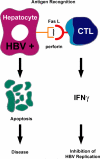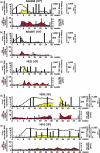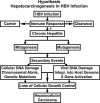Pathogenesis of hepatitis B virus infection
- PMID: 20116937
- PMCID: PMC2888709
- DOI: 10.1016/j.patbio.2009.11.001
Pathogenesis of hepatitis B virus infection
Abstract
The adaptive immune response is thought to be responsible for viral clearance and disease pathogenesis during hepatitis B virus infection. It is generally acknowledged that the humoral antibody response contributes to the clearance of circulating virus particles and the prevention of viral spread within the host while the cellular immune response eliminates infected cells. The T cell response to the hepatitis B virus (HBV) is vigorous, polyclonal and multispecific in acutely infected patients who successfully clear the virus and relatively weak and narrowly focussed in chronically infected patients, suggesting that clearance of HBV is T cell dependent. The pathogenetic and antiviral potential of the cytotoxic T lymphocyte (CTL) response to HBV has been proven by the induction of a severe necroinflammatory liver disease following the adoptive transfer of HBsAg specific CTL into HBV transgenic mice. Remarkably, the CTLs also purge HBV replicative intermediates from the liver by secreting type 1 inflammatory cytokines thereby limiting virus spread to uninfected cells and reducing the degree of immunopathology required to terminate the infection. Persistent HBV infection is characterized by a weak adaptive immune response, thought to be due to inefficient CD4+ T cell priming early in the infection and subsequent development of a quantitatively and qualitatively ineffective CD8+ T cell response. Other factors that could contribute to viral persistence are immunological tolerance, mutational epitope inactivation, T cell receptor antagonism, incomplete down-regulation of viral replication and infection of immunologically privileged tissues. However, these pathways become apparent only in the setting of an ineffective immune response, which is, therefore, the fundamental underlying cause. Persistent infection is characterized by chronic liver cell injury, regeneration, inflammation, widespread DNA damage and insertional deregulation of cellular growth control genes, which, collectively, lead to cirrhosis of the liver and hepatocellular carcinoma.
Copyright 2009 Elsevier Masson SAS. All rights reserved.
Figures





Similar articles
-
Hepatitis B virus immunopathogenesis.Annu Rev Immunol. 1995;13:29-60. doi: 10.1146/annurev.iy.13.040195.000333. Annu Rev Immunol. 1995. PMID: 7612225 Review.
-
Hepatitis B virus immunopathology.Springer Semin Immunopathol. 1995;17(2-3):261-81. doi: 10.1007/BF00196169. Springer Semin Immunopathol. 1995. PMID: 8571172 Review.
-
Hepatitis B virus transgenic mice: models of viral immunobiology and pathogenesis.Curr Top Microbiol Immunol. 1996;206:149-73. doi: 10.1007/978-3-642-85208-4_9. Curr Top Microbiol Immunol. 1996. PMID: 8608715 Review.
-
[Immunopathology of chronic liver diseases].Verh Dtsch Ges Pathol. 1995;79:186-97. Verh Dtsch Ges Pathol. 1995. PMID: 8600684 Review. German.
-
Host immunity influences disease progression and antiviral efficacy in humans infected with hepatitis B virus.Expert Rev Gastroenterol Hepatol. 2009 Oct;3(5):499-512. doi: 10.1586/egh.09.50. Expert Rev Gastroenterol Hepatol. 2009. PMID: 19817672 Review.
Cited by
-
Serum levels of microRNAs can specifically predict liver injury of chronic hepatitis B.World J Gastroenterol. 2012 Oct 7;18(37):5188-96. doi: 10.3748/wjg.v18.i37.5188. World J Gastroenterol. 2012. PMID: 23066312 Free PMC article.
-
Association between Interferon-Inducible Protein 6 (IFI6) Polymorphisms and Hepatitis B Virus Clearance.Genomics Inform. 2013 Mar;11(1):15-23. doi: 10.5808/GI.2013.11.1.15. Epub 2013 Mar 31. Genomics Inform. 2013. PMID: 23613678 Free PMC article.
-
Characterization of Full-Length Genomes of Hepatitis B Virus Quasispecies in Sera of Patients at Different Phases of Infection.J Clin Microbiol. 2015 Jul;53(7):2203-14. doi: 10.1128/JCM.00068-15. Epub 2015 Apr 29. J Clin Microbiol. 2015. PMID: 25926495 Free PMC article.
-
The novel mechanism facilitating chronic hepatitis B infection: immunometabolism and epigenetic modification reprogramming.Front Immunol. 2024 Jan 15;15:1349867. doi: 10.3389/fimmu.2024.1349867. eCollection 2024. Front Immunol. 2024. PMID: 38288308 Free PMC article. Review.
-
CD4+ T Cells Are Not Required for Suppression of Hepatitis B Virus Replication in the Liver of Vaccinated Chimpanzees.J Infect Dis. 2016 Jan 1;213(1):49-56. doi: 10.1093/infdis/jiv348. Epub 2015 Aug 31. J Infect Dis. 2016. PMID: 26324781 Free PMC article.
References
Publication types
MeSH terms
Grants and funding
LinkOut - more resources
Full Text Sources
Other Literature Sources
Medical
Research Materials

